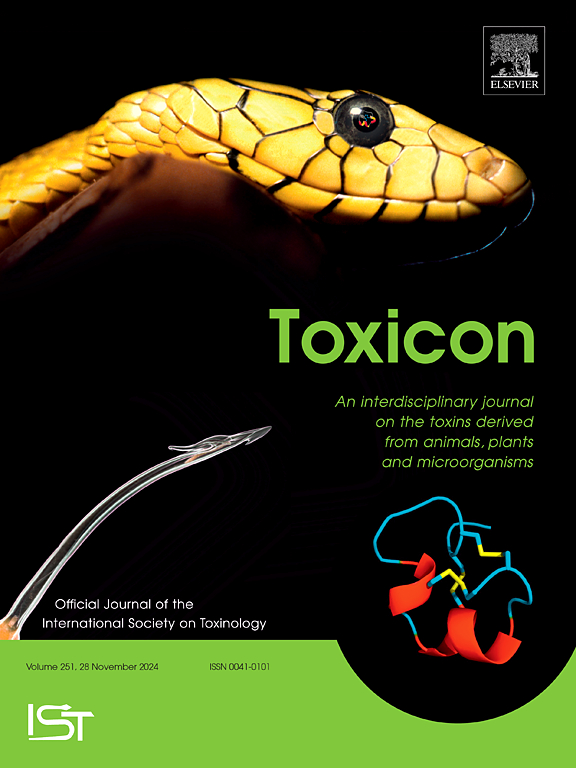Sorghum poisoning in ruminants and horses: a review
IF 2.6
4区 医学
Q2 PHARMACOLOGY & PHARMACY
引用次数: 0
Abstract
We reviewed the history, epidemiology, clinical signs, pathology, pathogenesis, treatment, control, and prophylaxis of Sorghum poisoning in livestock. Economic losses in the livestock industry associated with sorghum have been reported since the 19th century. Hyperacute/acute poisoning associated with cyanide (HCN) or nitrate/nitrite frequently occurs in ruminants that consume high quantities of growth and regrowth sorghum after drought, followed by rainfall, respectively. Chronic cystitis-ataxia syndrome primarily affects horses after weeks of grazing on sorghum pastures, while congenital arthrogryposis and axonopathy have been observed in pregnant ewes and cows grazing sorghum sprouts. The hyperacute/acute manifestations result from the blockade of the respiratory chain by cyanide. However, the pathogenesis of chronic exposure leading to spinal cord lesions, as well as the potential teratogenic effects of cyanide, including abortions and limb deformities in both livestock and humans, remains unknown. Sodium thiosulphate is recommended for the treatment of acute poisoning. Prophylaxis for sorghum poisoning includes avoiding grazing on plants younger than seven weeks, removing sorghum from the diet of poisoned animals, and being cautious with sorghum stover after rain due to regrowth risks.

反刍动物和马的高粱中毒研究进展
本文综述了家畜高粱中毒的历史、流行病学、临床症状、病理、发病机制、治疗、控制和预防。自19世纪以来,就有报道称与高粱有关的畜牧业的经济损失。与氰化物(HCN)或硝酸盐/亚硝酸盐相关的超急性/急性中毒经常发生在反刍动物身上,这些反刍动物分别在干旱和降雨后消耗大量生长和再生高粱。慢性膀胱炎-共济失调综合征主要影响在高粱牧场放牧数周后的马,而在吃高粱芽的怀孕母羊和奶牛中也观察到先天性关节挛缩性和轴索病。超急性/急性表现是由氰化物阻断呼吸链引起的。然而,长期接触氰化物导致脊髓损伤的发病机制,以及氰化物潜在的致畸作用,包括牲畜和人类的流产和肢体畸形,仍不清楚。建议用硫代硫酸钠治疗急性中毒。预防高粱中毒的措施包括避免食用七周以下的植物,将高粱从中毒动物的饮食中移除,并在雨后小心使用高粱秸秆,因为它有再生的风险。
本文章由计算机程序翻译,如有差异,请以英文原文为准。
求助全文
约1分钟内获得全文
求助全文
来源期刊

Toxicon
医学-毒理学
CiteScore
4.80
自引率
10.70%
发文量
358
审稿时长
68 days
期刊介绍:
Toxicon has an open access mirror Toxicon: X, sharing the same aims and scope, editorial team, submission system and rigorous peer review. An introductory offer Toxicon: X - full waiver of the Open Access fee.
Toxicon''s "aims and scope" are to publish:
-articles containing the results of original research on problems related to toxins derived from animals, plants and microorganisms
-papers on novel findings related to the chemical, pharmacological, toxicological, and immunological properties of natural toxins
-molecular biological studies of toxins and other genes from poisonous and venomous organisms that advance understanding of the role or function of toxins
-clinical observations on poisoning and envenoming where a new therapeutic principle has been proposed or a decidedly superior clinical result has been obtained.
-material on the use of toxins as tools in studying biological processes and material on subjects related to venom and antivenom problems.
-articles on the translational application of toxins, for example as drugs and insecticides
-epidemiological studies on envenoming or poisoning, so long as they highlight a previously unrecognised medical problem or provide insight into the prevention or medical treatment of envenoming or poisoning. Retrospective surveys of hospital records, especially those lacking species identification, will not be considered for publication. Properly designed prospective community-based surveys are strongly encouraged.
-articles describing well-known activities of venoms, such as antibacterial, anticancer, and analgesic activities of arachnid venoms, without any attempt to define the mechanism of action or purify the active component, will not be considered for publication in Toxicon.
-review articles on problems related to toxinology.
To encourage the exchange of ideas, sections of the journal may be devoted to Short Communications, Letters to the Editor and activities of the affiliated societies.
 求助内容:
求助内容: 应助结果提醒方式:
应助结果提醒方式:


